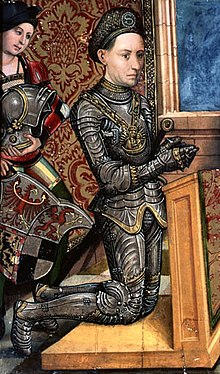
Sophia of Poland (Polish: Zofia Jagiellonka, 6 May 1464 – 5 October 1512), was a Polish princess member of the Jagiellonian dynasty and by marriage Margravine of Brandenburg-Ansbach and Brandenburg-Kulmbach.[1]
Born in Kraków, she was the second daughter of King Casimir IV of Poland of Poland and Archduchess Elisabeth of Austria. She was named after her paternal grandmother, Sophia of Halshany, Queen of Poland.
Sophia was baptised by John Gruszczynski, Bishop of Krakow. There is no information available concerning Sophia's upbringing or education.

Eric I, the Elder (German: Erich I, der Ältere) (1470 – 1540) was Duke of Brunswick-Lüneburg from 1495 and the reigning prince of Calenberg-Göttingen.
Eric I was born on 16 February 1470 in Neustadt am Rübenberge at the castle of Rovenburg. He was the founder of the Calenberg line of the House of Brunswick-Lüneburg. His father, William II, died in 1503, but had already divided his lands in 1495, between his sons, Henry and Eric. Eric was given the Principalities of Calenberg and Göttingen, whilst Henry received the Principality of Brunswick-Wolfenbüttel. Even as a boy, Eric had travelled as a pilgrim to Jerusalem and toured Italy before he entered the service of Emperor Maximilian I.
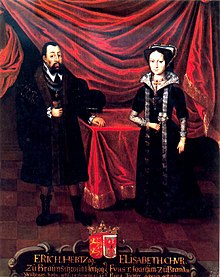
Elisabeth of Brandenburg (24 August 1510 – 25 May 1558) was a princess of the House of Hohenzollern and a Margravine ofBrandenburg by birth and by marriage Duchess of Brunswick-Göttingen-Calenberg and later and was Countess Consort ofHenneberg. She is considered a "reformation Princess", who, together with the Hessian reformer Anton Corvinus, helped theReformation prevail in today's South Lower Saxony.
Elisabeth was born, probably in Cölln, the third child and second daughter of the Elector Joachim I of Brandenburg and his wifeElisabeth, daughter of King John I of Denmark.[1] She was educated in a strictly religious and humanist fashion.

Albrecht VII, the Handsome, Duke of Mecklenburg in Güstrow (25 July 1486 – 5 January 1547), was a minor ruler in NorthGermany of the 16th century. He also asserted claims to Scandinavian thrones based on the royal lineage of the House of Mecklenburg.
In the course of the so-called Count's Feud, the Free City of Lübeck involved Duke Albrecht in its alliance with various parties and offered him the Danish crown. King Christian III of Denmark, however, managed to keep his kingdom: Christopher, Count of Oldenburg, and Duke Albert were besieged in Copenhagen in 1535-1536 until they capitulated.

Anna of Brandenburg (1 January 1507 died June 19, 1567 in Lübz) was a Princess of Brandenburg and by marriage Duchess ofMecklenburg.
Anna was the eldest daughter of the Elector Joachim I of Brandenburg (1484–1535) from his marriage to Elizabeth (1485–1555), daughter of King Johann of Denmark.
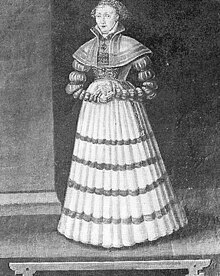
Albert of Prussia (17 May 1490 – 20 March 1568) was the last Grand Master of the Teutonic Knights, who after converting toLutheranism, became the first monarch of the Duchy of Prussia, the secularized state that emerged from the former Monastic State of the Teutonic Knights. Albert was the first European ruler to establish Lutheranism, and thus Protestantism, as the official state religion of his lands. He proved instrumental in the political spread of Protestantism in its early stage, ruling the Prussian lands for nearly six decades (1510–1568).
Albert was born in Ansbach in Franconia as the third son of Frederick I, Margrave of Brandenburg-Ansbach. His mother wasSophia, daughter of Casimir IV Jagiellon, Grand Duke of Lithuania and King of Poland, and his wife Elisabeth of Austria. He was raised for a career in the Church and spent some time at the court of Hermann IV of Hesse, Elector of Cologne, who appointed him canon of the Cologne Cathedral. Not only was he quite religious, he was also interested in mathematics and science, and sometimes is claimed to have contradicted the teachings of the Church in favour of scientific theories. His career was forwarded by the Church however and institutions of the Catholic clerics supported his early advance.
Turning to a more active life, Albert accompanied Emperor Maximilian I to Italy in 1508, and after his return spent some time in the Kingdom of Hungary.
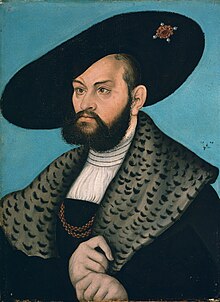
Dorothea of Denmark (1504–11 April 1547), was a Danish princess and Duchess of Prussia. She was the daughter of KingFrederick I of Denmark and Anna of Brandenburg. She was married to Duke Albert, Duke of Prussia.
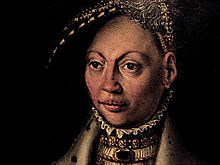
Enno II of East Frisia (died 1540 in Emden) was the son of Edzard I of East Frisia. In 1528 he became count of East Frisia. For most of his life he ruled together with Johan I of East Frisia, who remained Catholic, while Enno was Lutheran.

Anna of Oldenburg (14 November 1501 in Oldenburg – 24 September 1575 in Emden) was a Countess consort of East Frisia as the spouse of Count Enno II of East Frisia. She was the Regent of East Frisia in 1540/42–1561 as the guardian for her minor sons. Her reign lasted until 1561 and was generally supported by the Estates. Her chief advisor was her brother, count Christopher of Oldenburg. When she died in 1575, it was exactly 35 years after her own Husband's death.

Catherine of Saxe-Lauenburg (Katarina in Swedish) (24 September 1513 – 23 September 1535) was the first consort of Gustav I of Sweden and Queen of Sweden from 1531 until her death in 1535. She was born in Ratzeburg to Magnus I, Duke of Saxe-Lauenburg and Catherine, daughter of Henry IV, Duke of Brunswick-Lüneburg.

John V, Count of Oldenburg and Delmenhorst (also counted as John XIV, including also non-ruling namesake siblings; 1460,Oldenburg – 10 February 1526, Oldenburg) was a member of the House of Oldenburg. He was the ruling Count of Oldenburg from 1500 to 1526. His parents were Gerhard VI, Count of Oldenburg and Adelheid of Tecklenburg.

Augustus (31 July 1526 – 11 February 1586) was Elector of Saxony from 1553 to 1586.
Augustus was born in Freiberg, the youngest child and third (but second surviving) son of Henry IV, Duke of Saxony, and Catherine of Mecklenburg. He consequently belonged to the Albertine branch of the House of Wettin. Brought up as a Lutheran, he received a good education and studied at the university of Leipzig. [1]

Anne of Denmark or Anna (22 November 1532, Haderslev – 1 October 1585, Dresden[1]) was Electress of Saxony and Margravine of Meissen. She was a member of the House of Oldenburg.
Anne was the eldest child of King Christian III of Denmark and his wife Dorothea of Saxe-Lauenburg. Anne learned needlework from her mother as well as herbs, home care, and agriculture. In 1548, she married Augustus I of Saxony ( "Father of August"). She went on to have fifteen children; eleven of them would die young. The couple took up residence at Weissenfels. Before each birth she brought out her shrouds, so they'd be at hand in case of an emergency. She washed and churned herself, doctored her husband and also tried to gain influence on state affairs when court officials did not like the idea of "female domination" at the Saxon court. Elector August was furious, angry that he even changed his religious affiliation to his own form of Lutheranism.

Henry IV, Duke of Mecklenburg (1417 – 9 March 1477) was from 1422 to 1477 Duke of Mecklenburg.
Henry IV of Mecklenburg, because of his obesity and lavish lifestyle also called the "Henry the Fat", was the son of the Duke John IVof Mecklenburg and Catherine of Saxe-Lauenburg.

Dorothea of Brandenburg (9 February 1420, Berlin – 19 January 1491, Benedictine monastery at Rehna) was a princess ofBrandenburg by birth and by marriage Duchess of Mecklenburg.
Dorothea was a daughter of the Elector Frederick I of Brandenburg (1371–1440) from his marriage to Elisabeth (1383–1442), daughter of Duke Frederick of Bayern-Landshut. Elizabeth's brothers were Electors Frederick II and Albert Achilles, who successively ruled Brandenburg.
Eric II or Erich II (between 1418 and 1425 – 5 July 1474) was a member of the House of Pomerania (also known as the House of Griffins) and was the ruling Duke of Duke of Pomerania-Wolgast from 1457 to 1474. He was the son of Wartislaw IX of Pomerania-Wolgast and Sophia, daughter of Eric IV of Saxe-Lauenburg.

Sophia of Pomerania-Stolp (1435 – 24 August 1497), was a Duchess of Pomerania by birth, and married to Eric II, Duke of Pomerania.
Sophia was the daughter of Bogislaw IX, Duke of Pomerania and Maria of Masovia. In 1446, her father died and was succeeded by his cousin, Eric of Pomerania, former King of Denmark, Norway and Sweden. Sophia became the heir of Eric of Pomerania's private fortune. In 1451, Sophia was married to Eric of Pomerania-Wolgast, making her spouse the heir of Eric of Pomerania's territories, while Sophia remained the heir of Eric of Pomerania's private fortune. At the death of Eric of Pomerania in 1459, Sophia's husband united Pomerania through the inheritance of Pomerania-Stolp and Pomerania-Rügenwalde by his marriage, while Sophia became the sole possessor of the vast fortune brought by Eric of Pomerania from his former kingdoms's in Scandinavia, as well as the one he had acquired by his piracy activity on Gotland.
Juan I de Dinamarca (en danés y noruego Hans o Johan, en sueco Johan) (Aalborg, 2 de febrero de 1455 - Aalborg, 20 de febrero de 1513). Rey de Dinamarca (1481-1513), de Noruega (1483-1513), y con el nombre de Juan II, rey de Suecia(1497-1501). Hijo del rey Cristián I y de Dorotea de Brandeburgo.
Cristina de Sajonia (24 de septiembre de 1461 - 8 de diciembre de 1521). Reina de Dinamarca tras su matrimonio con Juan I. Por la herencia de su cónyuge, se convirtió en reina de la Unión de Kalmar, que incluía también a Noruega y Suecia. Era la mayor de los hijos de Ernesto de Sajonia e Isabel de Baviera y hermana de Federico el prudente.

Teodorico de Oldemburgo (en alemán Dietrich von Oldenburg 1390 - 14 de febrero de 1440) fue un señor feudal alemán, conde deOldemburgo y Delmenhorst.
Su primera esposa fue Adelheid von Oldenburg-Delmenhorst, quien falleció 1404. Se casó después con la princesa Heilwig von Holstein (1398-1436), hermana del duque Adolfo VIII de Holstein ambos decendientes de Adolfo I(primer duque de Holstein). Su primer hijo fue Cristián de Oldemburgo, que se convirtió en Rey de Dinamarca, [[Suecia y Noruega, como Cristián I y fue támbién Conde de Oldemburgo y Duque de Holstein.

Gerhard VI "the Quarrelsome", Count of Oldenburg (German: Gerhard (Gerd) der Mutige von Oldenburg; 1430 – 22 February 1500) was a Count of Oldenburg and regent of Bad Zwischenahn in 1440–1482.
Gerhard was the third son of Dietrich of Oldenburg and his wife, Helvig of Schauenburg. His eldest brother succeeded their father as Christian VI but was elected King Christian I of Denmark in 1448, therefore passing on the county to his brothers in 1450. In 1440–1463 Gerhard VI ruled in Delmenhorst as regent and in 1464–1482 (after the death of his brother Maurice) as the guardian of his nephew Jakob. He was constantly at war with Gerhard III, Prince-Archbishop of Bremen, and Frisians. In 1483 Gerhard was compelled to abdicate in favor of his sons, and he died whilst on a pilgrimage in the Rhône river valley.
John V of Saxe-Lauenburg (also numbered John IV;[1] 18 July 1439 – 15 August 1507) was the eldest son of Duke Bernard II of Saxe-Lauenburg and Adelheid of Pomerania-Stolp (*1410 – after 1445*), daughter of Duke Bogislaus VIII of Pomerania-Stolp. He succeeded his father in 1463 as duke of Saxe-Lauenburg.
Dorothea of Brandenburg (1446 – March 1519) was a princess of Brandenburg by birth and by marriage Duchess of Saxe-Lauenburg.
Dorothea was the eldest child of Elector Frederick II of Brandenburg (1413–1471) from his marriage to Catherine (1421–1476 ), daughter of Elector Frederick I of Saxony.
Henry (Latin Henricus; 14 June 1463 – 23 June 1514, Leer), Duke of Brunswick-Lüneburg, called Henry the Elder or Henry the Evil, was prince of Wolfenbüttel from 1491 until his death.
Henry's father, William IV, Duke of Brunswick-Lüneburg, retired in 1491, leaving government of Wolfenbüttel to his two sons, Henry the Elder, and Eric. In 1494, the brothers divided the territory between them, and Henry received the eastern part of the state, with the cities of Brunswick and Wolfenbüttel.
Catherine of Pomerania-Wolgast (German: Katherine von Pommern-Wolgast) (c. 1465–1526) was the wife of Henry IV, Duke of Brunswick-Lüneburg, Prince of Wolfenbüttel. She was the daughter of Eric II, Duke of Pomerania-Wolgast, and Sophia of Pomerania-Stolp.
She served as patron to physician Eucharius Rösslin, who dedicated his Der Rosengarten, a seminal work on childbirth, to her.
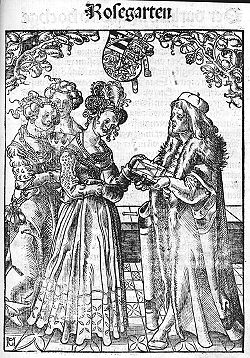
Ana Maria do Palatinado-Simmern (24 de julho de 1561 - 29 de julho de 1589) foi uma princesa alemã e princesa da Suécia por casamento, sendo a primeira esposa do futuro rei Carlos IX da Suécia. Morreu antes do marido se tornar rei, por isso nunca foi rainha.
Ana Maria era filha do príncipe-eleitor Luís VI do Palatinado e da landegravina Isabel de Hesse. Em Abril de 1578, o príncipe Carlos da Suécia visitou a cidade-natal de Ana, Heidelberg e pediu-a em casamento. O casamento celebrou-se em Heidelberg a 11 de Maio de 1579. Depois, Ana foi viver com o marido para a Suécia.

No hay comentarios:
Publicar un comentario